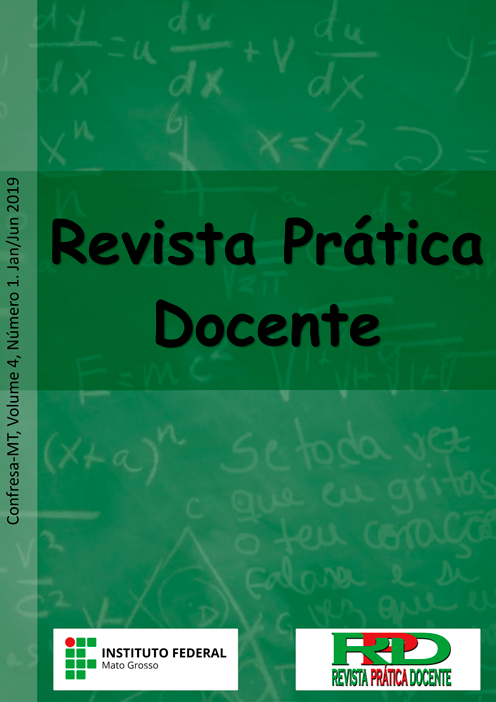CHARACTERISTICS OF THE THREE WORLDS OF MATHEMATICS THAT EMERGE IN SOLVING QUESTIONS INVOLVING THE CONCEPT OF LIMIT
DOI:
10.23926/RPD.2526-2149.2019.v4.n1.p80-95.id370Keywords:
Mathematics Education in Higher Education, Limit of a function, Three Worlds of MathematicsAbstract
The concept of limit of a function is conceived with one of the main, and also one of the most complex in the work with the disciplines of Differential and Integral Calculus (CDI), being the basis for learning the concept of derivative, for example. In this sense, in order to understand how students who have already studied a CDI discipline understand this concept, this study aims to analyze the characteristics of the Three Worlds of Mathematics proposed by Tall (2004; 2013) that students of two Mathematics Degree courses mobilize when solving questions involving the concept of limit. For that, a test with seven questions was proposed to the fourteen students of two courses of Mathematics Degree of the state of Rio Grande do Sul, of which, three are analyzed in this text, in view of the proposed theoretical framework. It can be concluded that most of the students present weak conceptual images in relation to this concept, being their learning based mainly on the characteristics of Conceptual Embodied World.
Downloads
Metrics
References
ANTON, Howard; BIVENS, Irl; DAVIS, Stephen. Cálculo. 8. ed. Porto Alegre: Bookman, 2007.
ARTIGUE, Michèle. La enseñanza de los princípios del cálculo: problemas epistemológicos, cognitivos y didácticos. In: ARTIGUE, M. et. al. Ingeniería Didáctica em Educación Matemática. Bogotá: Grupo Editorial IberoAmérica, 1995. p. 97-140.
BARUFI, Maria Cristina Bonomi A Construção/negociação de significados no curso universitário inicial de Cálculo Diferencial e Integral. 1999. Tese (Doutorado em Educação) – Universidade de São Paulo, São Paulo, 1999. Disponível em: < http://www.teses.usp.br/teses/disponiveis/48/48133/tde-06022004-105356/pt-br.php>. Acessado em: 31 jan. 2018.
BRASIL. Conselho Nacional de Educação. Parecer 1.302/2001. Institui Diretrizes Curriculares Nacionais para os Cursos de Matemática, Bacharelado e Licenciatura. Brasília, 2001. Disponível em: <http://portal.mec.gov.br/cne/arquivos/pdf/CES13022.pdf>. Acessado em 02 nov. 2017.
CURY, Helena Noronha; BAZZO, Walter Antonio. Formação crítica em Matemática: uma questão curricular? Bolema, Rio Claro, v. 14, n. 16, p. 29-47, 2001. Disponível em: < http://ojs-teste.biblioteca.unesp.br/index.php/bolema/article/view/10615>. Acessado em: 05 fev. 2019.
LOPES, Artur Oscar. Algumas reflexões sobre a questão do alto índice de reprovação nos cursos de Cálculo da UFRGS. Matemática Universitária, Rio de Janeiro, n. 26/27, p. 123-146, 1999. Disponível em: <https://rmu.sbm.org.br/wp-content/uploads/sites/27/2018/03/n26_n27_Artigo05.pdf>. Acessado em: 11 fev. 2019.
MEYER, João Frederico da Costa Azevedo, SOUZA JUNIOR. Arlindo José de. A utilização do computador no processo de ensinar-aprender Cálculo: a constituição de grupos de ensino com pesquisa no interior da universidade. Zetetiké, Campinas, v.10, n. 17/18, p. 113-148, jan./dez. 2002. Disponível em: <https://periodicos.sbu.unicamp.br/ojs/index.php/zetetike/article/view/8646945>. Acessado em: 11 fev. 2019.
SENA, Thainnã Thatisuane Oliveira; SOUZA, Ademária Aparecida. Causas de dificuldades no ensino-aprendizagem de Cálculo Diferencial e Integral na perspectiva dos alunos e dos professores do curso de Matemática da UFAL – Campus de Arapiraca. Proceeding Series of the Brazilian Society of Applied and Computational Mathematics, São Carlos, v. 3, n. 1, p. 1-2, 2015. Disponível em: <https://proceedings.sbmac.org.br/sbmac/article/view/807/813>. Acessado em: 28 fev. 2019. DOI: https://doi.org/10.5540/03.2015.003.01.0520
SOARES, Gabriel de Oliveira; CURY, Helena Noronha. As ideias de David Tall em um mapeamento de artigos de periódicos brasileiros. Revista Sergipana de Matemática e Educação Matemática, n. 1, p. 1-16, 2017a. Disponível em: <https://seer.ufs.br/index.php/ReviSe/article/view/7294>. Acessado em: 01 fev. 2019. DOI: https://doi.org/10.34179/revisem.v2i1.7294
SOARES, Gabriel de Oliveira; CURY, Helena Noronha. O conteúdo de limite em cursos de licenciatura em Matemática: uma pesquisa à luz da teoria dos três mundos da Matemática. ReBECEM, v.1, n. 1, p. 64-83, 2017b. Disponível em: <http://e-revista.unioeste.br/index.php/rebecem/article/view/18557/12196>. Acessado em: 15 fev. 2019. DOI: https://doi.org/10.33238/ReBECEM.2017.v.1.n.1.18557
STARON, Francielly. O monstro da reprovação em Cálculo Diferencial Integral. In: Conversando sobre extensão, 14., 2016, Ponta Grossa. Anais… Ponta Grossa, 2016. p. 1-7. Disponível em: <http://sites.uepg.br/conex/anais/anais_2016/anais2016/1329-4673-1-DR-mod.pdf>. Acessado em: 08 fev. 2019.
TALL, David. How humans learn to think mathematically. Cambridge: Cambridge University Press, 2013. DOI: https://doi.org/10.1017/CBO9781139565202
TALL, David. Thinking through three worlds of mathematics. In: INTERNATIONAL CONFERENCE FOR THE PSYCHOLOGY OF MATHEMATICS EDUCATION, 28., 2004, Bergen, Norway. Proceedings… Bergen: PME, 2004. p. 281–288.
ZUCHI, Ivanete; GONÇALVES, Mirian Buss. Investigação sobre os obstáculos de aprendizagem do conceito de limite. In: CONGRESSO BRASILEIRO DE ENSINO DE ENGENHARIA, 31., 2003, Rio de Janeiro. Anais... Rio de Janeiro: ABENGE, 2003. Disponível em: <http://www.abenge.org.br/cobenge/arquivos/16/artigos/NMT210.pdf>. Acessado em: 08 fev. 2019.
Downloads
Published
How to Cite
Issue
Section
License
Copyright (c) 2023 A Revista Prática Docente tem o direito de primeira publicação

This work is licensed under a Creative Commons Attribution-NonCommercial 4.0 International License.
Authors who publish in this journal agree to the following terms:
- Authors retain the copyright and grant the journal the right of first publication, with the paper simultaneously licensed under the Licença Creative Commons Attribution allows the sharing of the work with acknowledgment of authorship and initial publication in this journal.
- Authors are authorized to take additional contracts separately, for non-exclusive distribution of the version of the work published in this journal (e.g. publish in institutional repository or as a book chapter), with acknowledgment of authorship and initial publication in this journal.











